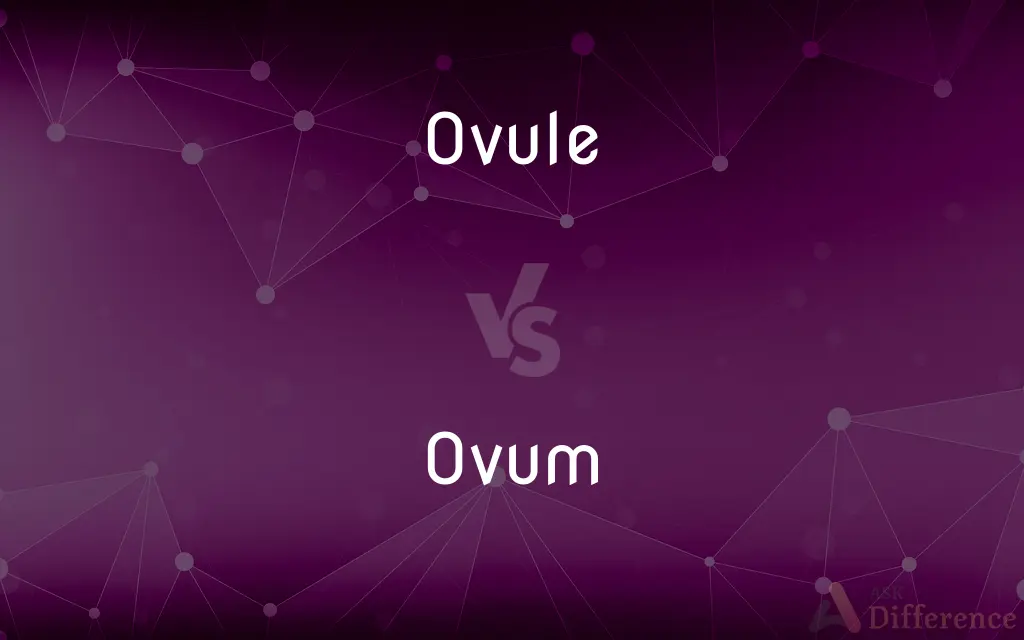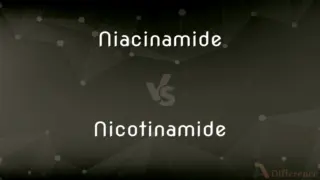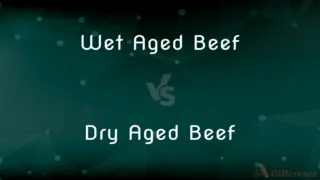Ovule vs. Ovum — What's the Difference?
Edited by Tayyaba Rehman — By Maham Liaqat — Updated on March 25, 2024
An ovule is a structure in seed plants that develops into a seed after fertilization, while an ovum is a mature female reproductive cell in animals, capable of developing into a new organism upon fertilization.

Difference Between Ovule and Ovum
Table of Contents
ADVERTISEMENT
Key Differences
Ovules are found in the ovary of seed plants and are pivotal in plant reproduction. They contain a female gametophyte that, upon fertilization, develops into a seed. On the other hand, an ovum, often referred to as an egg, is the female gamete in animals, including humans, that fuses with a male gamete to form a zygote, which can then develop into a new individual.
The development of an ovule into a seed represents a critical phase in the life cycle of seed plants, involving processes like pollination and fertilization. Whereas the ovum's role in fertilization is a fundamental aspect of reproduction in animals, leading to the development of an embryo.
Ovules are encased within the ovary of a plant and after fertilization, they develop into seeds, which can germinate into new plants. In contrast, an ovum is typically a single cell released from the ovaries of female animals during ovulation, awaiting fertilization by a reproductive cell.
The formation of ovules in plants involves a complex process including meiosis and mitosis within the ovule structure, leading to the formation of the female gametophyte. Conversely, the ovum is formed through oogenesis, a specialized form of meiosis in female animals, resulting in a cell ready for fertilization.
Structurally, ovules are attached to the ovary wall via a stalk called a funiculus and are surrounded by protective integuments, except for a small opening called the micropyle. An ovum, however, is a solitary cell, often surrounded by a protective layer called the zona pellucida in mammals, designed to facilitate penetration during fertilization.
ADVERTISEMENT
Comparison Chart
Found In
Seed plants
Animals, including humans
Function
Develops into a seed after fertilization
Develops into a new organism upon fertilization
Location
Ovary of a plant
Ovaries of female animals
Development Process
Involves meiosis and mitosis, forms female gametophyte
Formed through oogenesis, a form of meiosis
Structure
Attached to ovary wall, has protective integuments
Single cell, often surrounded by zona pellucida
Compare with Definitions
Ovule
Attached to the ovary wall via a funiculus.
The funiculus provides nutrients to the developing ovule.
Ovum
Formed through oogenesis.
Oogenesis results in a haploid ovum ready for fertilization.
Ovule
Contains female gametophyte.
The ovule's gametophyte will develop into a seed upon successful fertilization.
Ovum
A mature female reproductive cell in animals.
The ovum is much larger than the cell and contains vital nutrients.
Ovule
Protected by integuments, except at the micropyle.
The pollen tube enters the ovule through the micropyle.
Ovum
Surrounded by a protective layer like the zona pellucida.
The zona pellucida plays a crucial role in the fertilization process.
Ovule
A structure in seed plants that develops into a seed after fertilization.
The magnolia's ovules are fertilized by the pollen carried by beetles.
Ovum
Capable of developing into a new organism when fertilized.
Once the ovum is fertilized, it begins the process of embryonic development.
Ovule
Encased within the ovary, awaiting fertilization.
In flowering plants, ovules are enclosed in the ovary which becomes the fruit.
Ovum
(cytology) The female gamete in animals; the egg cell.
Ovule
(Zoology) A small or immature ovum.
Ovum
The mature female gamete of an animal; an egg.
Ovule
In seed plants, the ovule is the structure that gives rise to and contains the female reproductive cells. It consists of three parts: the integument, forming its outer layer, the nucellus (or remnant of the megasporangium), and the female gametophyte (formed from a haploid megaspore) in its center.
Ovum
A more or less spherical and transparent cell, which by a process of multiplication and growth develops into a mass of cells, constituting a new individual like the parent; an egg, spore, germ, or germ cell. See Illust. of Mycropyle.
Ovule
(Botany) A structure in seed plants that consists of the embryo sac surrounded by the nucellus and one or two integuments and that develops into a seed after it is fertilized.
Ovum
One of the series of egg-shaped ornaments into which the ovolo is often carved.
Ovule
(botany) The structure in a plant that develops into a seed after fertilization; the megasporangium of a seed plant with its enclosing integuments.
Ovum
The female reproductive cell; the female gamete
Ovule
(zoology) An immature ovum in mammals.
Ovule
The rudiment of a seed. It grows from a placenta, and consists of a soft nucleus within two delicate coatings. The attached base of the ovule is the hilum, the coatings are united with the nucleus at the chalaza, and their minute orifice is the foramen.
Ovule
A small body that contains the female germ cell of a plant; develops into a seed after fertilization
Ovule
A small or immature ovum
Common Curiosities
What is an ovule?
An ovule is a structure in seed plants that, upon fertilization, develops into a seed.
Where are ovules found?
Ovules are found within the ovaries of seed plants.
What is an ovum?
An ovum is the mature female gamete in animals, capable of developing into a new individual upon fertilization.
How do ovules become seeds?
Ovules develop into seeds after the fertilization of the female gametophyte within them, leading to seed formation.
Do all plants produce ovules?
Only seed plants produce ovules; non-seed plants reproduce through different mechanisms.
What's the significance of the micropyle in ovules?
The micropyle is an opening in the ovule that allows pollen to enter for fertilization.
Can ovules be found in animals?
No, ovules are specific to seed plants, whereas animals produce ova or eggs.
How does the structure of an ovum facilitate fertilization?
The ovum's structure, particularly the zona pellucida, facilitates penetration for successful fertilization.
Can an ovum develop into a plant?
No, an ovum is an animal reproductive cell; it cannot develop into a plant.
Why is the ovum considered a critical element in reproduction?
The ovum is critical because it not only carries half the genetic material needed for a new organism but also provides the necessary nutrients for the early stages of development.
How is an ovum formed?
An ovum is formed through oogenesis, a process of meiosis that produces haploid female gametes.
What roles do the funiculus and integuments play in ovules?
The funiculus attaches the ovule to the ovary wall, and the integuments protect the ovule, leaving only the micropyle open for fertilization.
Are ovules visible to the naked eye?
Generally, ovules are too small to be seen without magnification, though some large-seeded plants may have visibly discernible ovules.
Share Your Discovery

Previous Comparison
Anti vs. Pro
Next Comparison
Gin vs. RumAuthor Spotlight
Written by
Maham LiaqatEdited by
Tayyaba RehmanTayyaba Rehman is a distinguished writer, currently serving as a primary contributor to askdifference.com. As a researcher in semantics and etymology, Tayyaba's passion for the complexity of languages and their distinctions has found a perfect home on the platform. Tayyaba delves into the intricacies of language, distinguishing between commonly confused words and phrases, thereby providing clarity for readers worldwide.















































